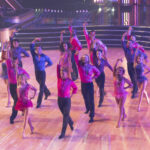The allure of Arab Dance music transcends cultural boundaries, captivating listeners with its exotic melodies and rhythms. Among the most iconic examples is “Arabian Dance” from Pyotr Ilyich Tchaikovsky’s timeless ballet, The Nutcracker. This piece, often referred to as “arab dance,” is more than just a musical segment within a larger work; it’s a rich tapestry of history, emotion, and cross-cultural inspiration.
Unveiling the Historical Roots of the “Arabian Dance” Melody
While widely known as “Arabian Dance,” the melody Tchaikovsky employed actually has deep roots in Georgian folk music. Intriguingly, Tchaikovsky discovered this hauntingly beautiful tune during his time in Tbilisi, Georgia, a place where he also found inspiration for his acclaimed Sleeping Beauty ballet. Far from being an original composition in the purest sense, the “Arabian Dance” melody is borrowed from a traditional Georgian lullaby. These lullabies were sung by mothers to soothe their sick children, imbued with a tenderness and sorrow that resonates even today.
Adding another layer of depth, it’s been noted that this very melody mirrors the rhythmic cadence of Orthodox funeral rites. This connection underscores the melancholic undercurrent within the seemingly exotic and playful “Arabian Dance,” suggesting a deeper emotional complexity than initially perceived. Interestingly, Ippolitov-Ivanov, a contemporary composer of Tchaikovsky, also incorporated this melody into his works, highlighting its prominence and captivating nature within the musical landscape of that era.
Tchaikovsky’s Personal Resonance and the Nutcracker Suite
The creation of The Nutcracker Suite, including the “Arabian Dance,” was a deeply personal journey for Tchaikovsky. Tragically, the commission to write the ballet coincided with the passing of his sister. Music became his solace, a way to channel his grief and longing. He described the Nutcracker as a “musical idealization of his childhood,” a nostalgic yearning for happier times spent with his sister. This personal context infuses the “Arabian Dance” with an added layer of poignancy, transforming it from a mere exotic dance interlude into a reflection of personal loss and remembrance.
A Modern Interpretation: Aaron Embry, Brett Farkas, and Beatrice Reimagining “Arabian Dance”
In 2020, amidst a global atmosphere of uncertainty, musicians Aaron Embry and Brett Farkas, along with Beatrice, embarked on a project to record their unique interpretation of “Arabian Dance.” For Brett, the Nutcracker Suite held a special place, harking back to childhood memories of attending ballet performances and being particularly drawn to the “Arabian Dance” with its captivating melody that subtly shifts between minor and major keys.
Their collaboration began serendipitously. Brett, practicing the piece and consulting original Russian scores, played “Arabian Dance” at a casual gathering. Aaron, recognizing the melody instantly, joined in on the Wurlitzer, improvising the orchestral accompaniment from memory. This spontaneous musical connection sparked the idea for a recording project.
Driven by a shared love for this deeply evocative music, Aaron and Brett, with Beatrice, spent time in Ojai, California, meticulously crafting their rendition. Their version remains faithful to the original composition while incorporating their own artistic liberties. This recording serves as a testament to the enduring power of Tchaikovsky’s “Arabian Dance,” its historical depth, and its capacity to resonate across time and inspire new interpretations.
The Enduring Appeal of Arab Dance Music
“Arabian Dance,” in its various forms and interpretations, continues to enchant audiences worldwide. Whether experienced within the context of The Nutcracker ballet or as a standalone piece, its blend of exoticism, historical depth, and emotional resonance ensures its lasting appeal. Explore the world of arab dance music and discover the magic within Tchaikovsky’s masterpiece.

